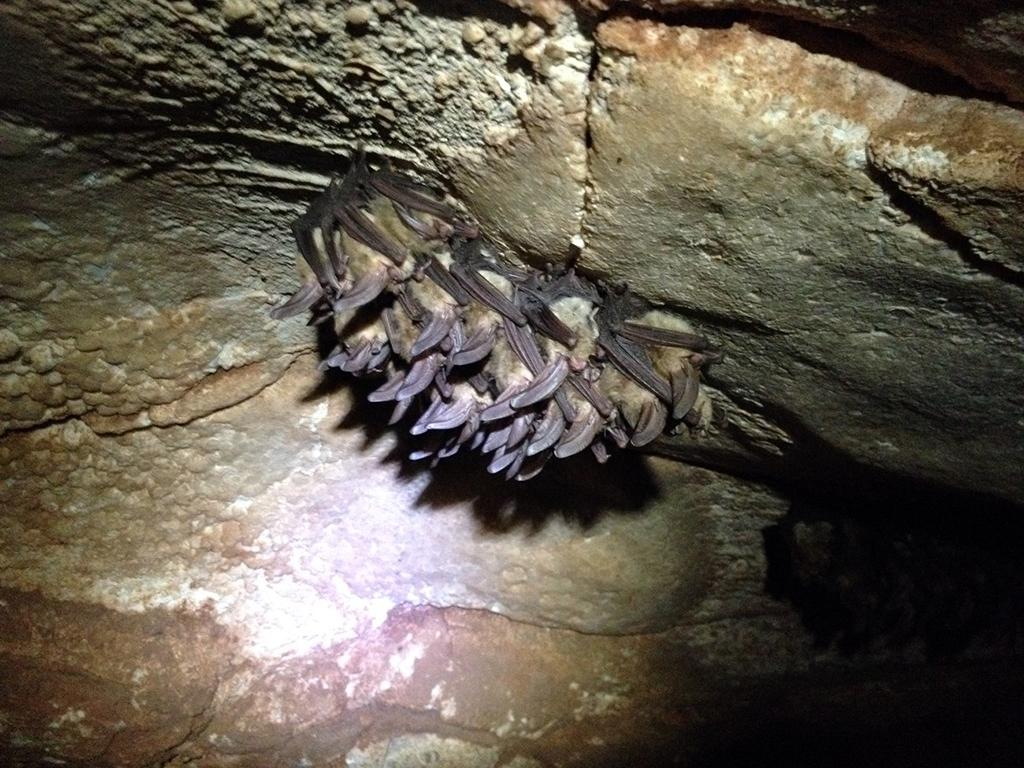Jewel Cave National Monument hosts one of the largest bat hibernations in the western United States, with 10 species living there year-round and 7 species making the cave their winter home (hibernaculum). Some bats, don’t even live in the cave. The hoary bats and the silver-haired bats, for instance, roost in trees at the national monument.

Bats hibernating in the historic entrance of Jewel Cave National Monument / Lydia Austin
A 2018 mid-winter bat count found over 1400 bats hibernating in Jewel Cave, over half of which were Townsend’s big-eared bats (Corynorhinus townsendii), while the rest were Myotis species (Myotis sp.) and a few Big Brown bats (Eptesicus fuscus). Subsequent winter bat counts have seen fewer numbers and the reasons are unknown – possibly white-nose syndrome or perhaps just relocation to other areas.
Of the bat species living and hibernating at Jewel Cave, one of the largest known hibernating colonies in the world are Townsend's big-eared bats.
Bats are good for the environment and good for humans, too. These furry little mammals living within the Black Hills are insectivorous, meaning they feed on beetles, moths, flies, and mosquitoes. A single little brown bat (M. lucifugus) can catch hundreds of mosquitoes in an hour.
Jewel Cave is a good hibernaculum for so many bats because its many levels near the historic entrance have such a variety of temperatures and wind conditions for various roosting species. Some bats roost on walls and hang from ceilings in areas with strong airflow and significant climatic fluctuations, while other bat species like a more warm, stable environment.
Bats at Jewel Cave are at risk like bats everywhere else. They are slow-growing and slow-reproducing, rearing a single pup per year. Some bat species don’t mature enough to reproduce until the age of two or three years, and even though some species can live up to 30 years, the average for some bats is 6 years and for others, 16 years.
When bats hibernate, their metabolism slows. If they are interrupted during their hibernation, their metabolism speeds up, exhausting their energy reserves. Repeated interruptions result in a lack of enough fat and water reserves to survive through the winter. To protect hibernating bats, no one is permitted to enter the historic entrance of Jewel Cave from October through May. The only exception is for the mid-winter bat count, which is conducted once a year by the park’s resource management staff.
People attempting to get rid of bats from their property – perhaps over the fear of rabies - may cause adult female bats to abandon their young before they can fly and capture food. This could result in starvation of the pup. When necessary, bat exclusion - a process that involves identifying and sealing all entry and exit points for bats in a building, while also installing one-way exit devices to allow bats to leave but not return - should be accomplished before the bats arrive, or after they leave the roosts in late summer. It’s also a good idea to provide alternate bat roosting sites nearby, before excluding bats. Remember, the Black Hills bats eat insect pests.
As for bats and rabies, less than 1 percent of bats in nature have rabies. Of course, that doesn’t mean you shouldn’t be wary if you encounter a bat acting strangely or aggressively toward you. Those bats are up to ten times more likely to have rabies. If you see a dead bat or a bat that is behaving strangely, such as being aggressive, lying on the ground, flying near, or making contact with people, communicate with a park ranger right away, and do not touch the bat.
Bats are also threatened by predators. They are a food source for owls, hawks, snakes, and domestic and feral cats. If you see a cat anywhere in the monument, please report it at the visitor center. Park staff will trap the cat and take it to a shelter.
Another threat to bats is white-nose syndrome. This disease is caused by a fungus that was first found in New York and has spread to many caves throughout the United States. Learn more about this disease on our White-Nose Syndrome page. The threat of white-nose syndrome is the reason Jewel Cave’s ranger-guided tours require attendees to walk through a decontamination tray at the end of the tour, prior to leaving the cave and entering the elevators.






